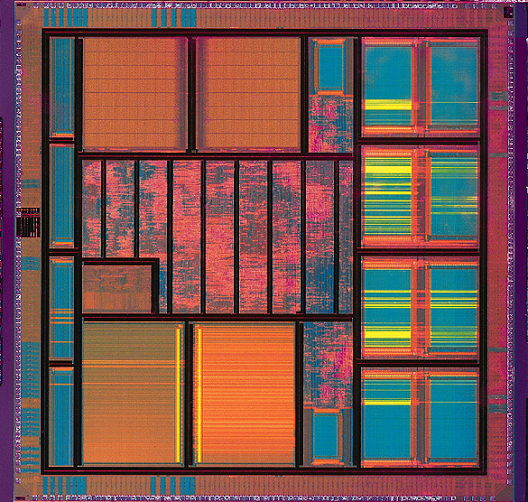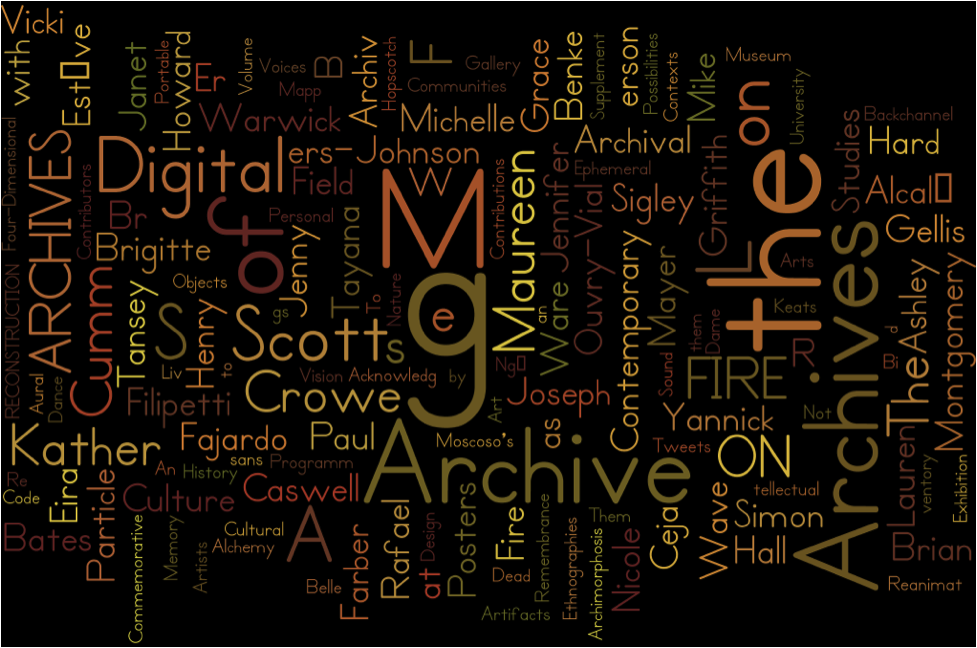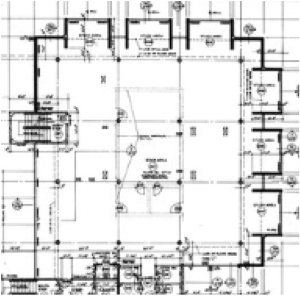Reconstruction Vol. 16, No. 1
Return to Contents»
Archives on Fire: Particle, Wave, and Field / W. Scott Howard
"In a culture like ours, long accustomed to splitting and dividing all things as a means of control, it is sometimes a bit of a shock to be reminded that, in operational and practical fact, the medium is the message. This is merely to say that the personal and social consequences of any medium—that is, of any extension of ourselves—result from the new scale that is introduced into our affairs by each extension of ourselves, or by any new technology."
—Marshall McCluhan, "The Medium is the Message," Understanding Media: The Extensions of Man (Cambridge: MIT, 1964).
"There's a level at which words are spirit and paper is skin. That's the fascination of archives. There's still a bodily trace […] When you see the material objects, in all their variety of shapes and surfaces, it's like coming on unexplained spirits singing into air."
—Susan Howe, interviewed by Maureen N. McLane, "The Art of Poetry, No. 97," The Paris Review 203 (2012).
<1> When Justin Scott-Coe and I were co-editing Water: Resources & Discourses—the multigraph for Reconstruction 6.3 (Summer 2006)—and then again, in 2007 and 2008, when I was organizing the first volumes for Reconfigurations and Appositions, I became increasingly fascinated with integrated circuits, especially the Atmel Diopsis 740 (imaged above and at the top of our TOC for this collection) [i]. I began thinking in new ways about technology and about digital media in particular, and I began asking myself new questions about relationships between content and form, figure and ground, data and interfaces, artifacts and archives. [ii] Now, I'm neither a computer engineer nor a programmer, and can write only basic HTML, and really know next to nothing about how the web actually works, or how my touchscreen device is assembled, or, for that matter, about microchips—except that they are astonishingly beautiful and vital archives on fire.
<2> Binary formulations such as these, above, are complex analytic metaphors (not unlike metaphysical conceits) [iii] that generate the illusion that such distinctions can, in the first place, be made at all and, further, that such antitheses matter more than what they signify through their highly-charged (which is to say, mediated) transference of meaning. [iv] When we invoke the word artifact/artefact, how many different sorts of humanly made or technologically produced or administratively generated objects or records or works are signified? [v] And when we invoke the word archive/archives, how many different collections or processes of accumulation or organizational structures or locations for such activities are signified? [vi] What we mean by any of these conceptual formulations depends entirely upon the uniqueness simultaneously at stake for each taken together. And, in all cases, these words concern on-going processes of mediation and remediation, exchange and interpretation, containment and subversion, adaptation and deformation, etc.
<3> Each art(i/e)fact and every archive(s) is specific to the uniqueness that matters most to the communities and fields within and across
which such records, objects, systems, and places are, to echo Marshall McCluhan, "introduced into our affairs by each extension of ourselves, or by any new
technology." The medium is the message. Our general title for this special topic collection underscores such heterogeneous attunement: Archives on Fire (Artifacts & Works, Communities & Fields). And yet, and yet […] such dynamic relationships among every
artifact/artefact and each archive/archives dwell in generative paradoxes between physical and phenomenal, tangible and intangible realms. As Susan Howe
avers: "When you see the material objects, in all their variety of shapes and surfaces, it's like coming on unexplained spirits singing into air."
The medium is the message. Something next to nothing figures into these polysemous relationships among artifacts and
archives—absence, chance, discovery, echoes, glitches, intuitions, links, magic, mistakes, networks, silence, spirits, traces—something not unlike
quantum synergy matters a great deal. Something akin to the wave-particle duality
is at work here because "every elementary [artifact or artifactual] entity exhibits the properties of not only [artefacts], but also" simultaneously of an
archive/s, and vice versa. "Archives on Fire: Particle, Wave, and Field" suggests one possible way of reconfiguring such entanglements, which you'll see
reflected in our TOC and most vitally engaged in our contributors' multi-disciplinary and multi-modal works:
<4> Such phenomena figure into these relationships among artifacts and archives; such tangible/intangible matters subvert capture and conversion (in every sense of that word) even as they spark our creativity and critique. In an essay that reflects upon our work at Reconfigurations, I attempted, in 2011, to describe such things in terms of wysiwyg poetics, outlining (via Gadamer, Kristeva, Lev Manovich, Jay David Bolter, Diane Gromala, and Johanna Drucker, among others) a five-fold epistemology for emergent digital practices that would integrate noetic (intuition), ludic (play), hylic (matter), thetic (setting forth), and predicative (syntactic) registers. Drucker's more apt notion of configuration, for example, seems especially resonant for our work here in Archives on Fire:
"the nature of configured meaning within code (again, at the fundamental level of stored, binary sequences) should be read back into the material world in its variously layered interpretations: the first, meta-level of idea coming into being as form and grasped as sense, which I take to be the originary inscription of code; the secondary level, in which form is read as meaning, with all the complexities of iconography, symbolic imagery, and aesthetic inflection; and a third level in which style and specificity engage with ideology, with the specific historical, cultural, and institutional discourses of power." (174)[vii]
<5> Integrated circuits have exquisite architectural micro-cosmic designs for memory block placement, partitioning, pin placement, power planning, and peripheral input/output pad positioning. Their multi-dimensional floorplannings resemble cities with roadways, intersections, and viaducts; sidewalks, parks, and open-spaces. Their components are comparable to buildings (which are designed for different jobs) interconnected by hardware, but, as I've learned, there's at least one important difference between an IC and a city. Integrated circuits are constellations of finite numbers of standard components that may be assembled in an infinite number of ways to serve an equally infinite number of standard tasks. Cities, however, are infinitely complex systems for predictably unpredictable human (hence, finite) activities, for commerce and chaos, for dwelling and disappearance; each and every place, an expression of individuality in dialogue with a shifting environment precariously situated upon the migratory crust of the lithosphere on the third planet from the Sun in a macro-cosmic integrated system. Some difference.
<6> When I first saw this image of the Atmel Diopsis 740, I was instantly transported back to my undergraduate days at Lewis & Clark College—that is, precisely to the second floor of the Aubrey R. Watzek Library. This is where I wrote my honors thesis, which explored Montaigne's influence on a few of Shakespeare's plays (Hamlet, especially) concerning Pyrrhonian skepticism, Epicurean ataraxia (ἀταραξία, or thoughtful detachment), and new modalities of remembering and forgetting in early modern print cultures. [This last sentence, obviously, makes my senior thesis much more appealing to my interests today]. My favorite alcove was the one in the south-east corner. Here's a screen shot of part of that floorplan, c. 1967:
<7> Hamlet's active resistance "whilst / this machine is to him" (2.2.131-132) to
avenge his father's murder charges his existential and political critique of knowledge systems: how and why some human activities (and not others) are
recorded and/or erased; how and why such records are organized and/or disorganized; how and why access to such records is granted and/or denied and to whom
and when and under which conditions; and (with special consideration for spirits) how and why some forms of action and expression are most valuable
because of their ephemerality or mutability, their invisibility or irremediability
.[viii] In order to decipher the ghost's artifactual significance, Hamlet must first learn how to read, write,
and revise—that is, how to remediate—the archive sous-rature (under erasure):
"Remember thee?
Ay, thou poor ghost, whiles memory holds a seat
In this distracted globe. Remember thee?
Yea, from the table of my memory
I'll wipe away all trivial, fond records,
All saws of books, all forms, all pressures past,
That youth and observation copied there,
And thy commandment all alone shall live
Within the book and volume of my brain,
Unmixed with baser matter." (I.5.102-111)
<8> After sufficient time for reading and writing in one of the alcoves on the library's second floor (when I had reached a moment of exhaustion or exhilaration) I would gather my assorted technologies (e.g. papers, books, journals, photocopies, notes, pencils, pens, erasers, paperclips, bookmarks, etc.) and walk downstairs to the northern side of the first floor, where I would engage in a newfangled process of remediation that was at that time (c. 1987) energizing and also, quite frankly, sometimes terrifying. I would transcribe my analogue manuscript into digital text by way of a machine measuring 13.6" H x 9.6" W x 10.9" D and weighing 16.5 lbs. This marvelous thing, of course, was the Mac Plus ED. I remember my awkwardness and worries: "How does this thing work? What's up with all of these new sounds and sensations? What's happening to my writing? Can I really trust these floppy disks?"
<9> Hamlet's critique of knowledge systems—of plays within plays within plays, etc. (2.2.633)—at the boundaries between remediable and irremediable records quickly became my own set of everyday archival and artifactual problems: "How should I organize all of these files and folders? What would I do if I lost all of my work?! Would I be able to get it back?" And, if the data were erased, would the rest really be silence, as Hamlet tells Horatio in his famous last words? Shakespeare's text, of course, playfully speaks from the unspeakable other side of Hamlet's disappearance—"the rest is silence. / (O, O, O, O!)" (5.2.395-396)—which, today, readily converts to 01010101 in binary, to 85 in decimal, to 55 in hexadecimal, to 8 bits, to an equation of 64 + 16 + 4 + 1, and to a visualization, thus:
<10> Something next to nothing matters indeed. These moments from 1987 chart the emergence of my abiding fascination with archives that informs my teaching, scholarship, and creative work in various combinations of print and visual, analogue and digital media. In this regard, my experience is certainly not unique and merely participates, to echo McCluhan, in the personal, generational, and social "consequences of any medium—that is, of any extension of ourselves—[resulting] from the new scale that is introduced into our affairs by each extension of ourselves, or by any new technology." Or, in other words, as Howe's kaleidoscopic transformations (2013-15) of TOM TIT TOT dramatize: artifacts and archives are "TANGIBLE THINGS / Out of a stark oblivion." The message is the remediation.
<11> Theatrical and cinematic productions of Hamlet often take their cues for set design and mise-en-scène from Hamlet's raging against the machine, which suggests not only a critique of knowledge systems, but of the innumerable significations of that word (such as "a material or immaterial structure," "a scheme or plot," "the human body," "a military engine or siege-tower," and "a complex device, consisting of a number of interrelated parts, each having a definite function") as the Oxford English Dictionary observes. Since the advent of the World Wide Web (c. 1989) this one play from Shakespeare (more than any other) has inspired a robust field of technological and posthumanist theorizing.[ix] Shakespeare, McCluhan, and Howe share a deft attunement to chiasmal intersections between form and content, ground and figure in all media. Such connections informing the artifactual and the archival are more dynamically charged today than ever, and these generative tensions are increasing exponentially via recent, new, and emergent technologies (such as Google Glass, 3D printing, the Parallella Project, VR- and AI-search) that will continue to transfigure our work and world.
<12> Archives today are on fire—energized and endangered, mobile and mutable, ubiquitous and unique—as the library's heterogeneous forms and functions in society undergo significant changes. Digital tools, open-access platforms, and social networks are transforming all of the fields of creative practice, scholarly research, and knowledge production in the Arts, Humanities, and Sciences. These quantum forces are sparking new interest in artifacts and ephemera, visual and audio cultures, manuscripts and printed texts, micro-histories and intentional communities. Networks for communication and production are shaping diversity and innovation within and across the disciplines. Hybrid forms of gnosis (knowledge) and praxis (action) challenge aesthetic, generic, and methodological standards, reconfiguring frameworks for authorship and audience, content and copyright, personae and politics within and beyond academia. Archives are vital forces of and for social change.
Notes
[i] I wish to express my gratitude and thanks to Marc Ouellette, Alan Clinton, Joe McDermott, and Maria-Carolina Cambre for the invitation to curate this multigraph as well as for their sage advice and technical expertise without which this collection would not have been possible.
[ii] Reconfigurations and Appositions are the two peer-reviewed open-access journals that I founded and continue to edit and publish. Both journals have international editorial boards, Library of Congress ISSNs, Creative Commons licensing, MLA indexing, and EBSCO distribution. For essays that chart the progress of each journal, see respectively "WYSIWYG Poetics: Reconfiguring the Fields for Creative Writers & Scholars,"The Journal of Electronic Publishing, ed. Aaron McCollough. 14.2 (2011): http://dx.doi.org/10.3998/3336451.0014.204; and "APPOSITIONS at Work: Reflections on Open-Access Publishing," Journal for Early Modern Cultural Studies 13.4 (2013): 139-43.
[iii] See The New Princeton Encyclopedia of Poetry and Poetics (Princeton: Princeton University Press, 1993). Conceit: "A complex and arresting metaphor, in context usually part of a larger pattern of imagery, which stimulates understanding by combining objects and concepts in unconventional ways; in earlier usage, the imagination or fancy (qq.v.) in general. Derived from the It. concetto (concept), the term denotes a rhetorical operation which is specifically intellectual rather than sensuous in origin. Its marked artificiality appeals to the power of reason to perceive likenesses in naturally dissimilar and unrelated phenomena by abstracting from them the qualities (or logical 'places') they share […] [D]istinctly conceptual vehicles of comparison characterize the metaphysical c. […] for here internal qualities are conveyed by vehicles with which they share no physical features […] Ever since Donne, the first and foremost of the metaphysicals, took erotic and, later, religious love for his themes, the ingeniousness of the metaphysical c. has been associated with esp. intense sensual and spiritual experience. Aiming at describing the incomparable nature of that experience by way of figural comparisons, Donne's imagery veered from the concrete toward objects of essentially abstract content (the book, the mind, the tear, the picture) and of cosmological proportions (the sun, the heavens, the sphere), and such rhetorical figures as hyperbole, catachresis, and paradox (qq.v.). The antimimetic logic of the metaphysical c. allowed for extended metaphor sometimes bordering on allegory (q.v.), but usually returning to restate the opening terms of its analogy, as in Donne's famous figure, in A Valediction: Forbidding Mourning, of lovers' souls as compass legs" (231-32).
[iv] Metaphor has a rich etymology that includes the ancient Greek "μεταϕορά <μετα- meta- prefix +ϕορά carrying (< the o -grade of the stem ofϕέρειν to bear, carry: see bear v.1), after μεταϕέρειν, to transfer," all of which underscores the word's inherent meaning as not merely a figure of speech, but an energetic transference or carrying of signification "to an object or action different from, but analogous to, that to which it is literally applicable" (OED). See Paul Ricoeur, "The Metaphorical Process as Cognition, Imagination, and Feeling," Critical Inquiry 5.1 (1978): 143-59. Julia Kristeva's formulation of the semiotic chora (χώρα) goes one step further to critique such phenomenological readings of poetic figuration (which give priority to thetic consciousness). Kristeva positions the dynamics of metaphor vis-à-vis "a heterogeneousness to meaning and signification […] detected genetically in the first echolalias of infants as rhythms and intonations anterior to the first phonemes, morphemes, lexemes, and sentences [… that …] operates through, despite, and in excess of it and produces in poetic language 'musical' but also nonsense effects that destroy not only accepted beliefs and significations, but in radical experiments, syntax itself, that guarantee of thetic consciousness (of the signified object and ego)" (1167). See Julia Kristeva, "From One Identity to Another," trans. Thomas Gora, Alice Jardine, and Leon S. Roudiez, Critical Theory Since Plato, ed. Hazard Adams (Fort Worth: Harcourt Brace Jovanovich, 1992), 1163-73.
[v] From the OED: "Artifact/Artefact. n. 1. a. An object made or modified by human workmanship, as opposed to one formed by natural processes. b. Archaeol. An excavated object that shows characteristic signs of human workmanship or use. c. In fantasy role-playing games, computer games, etc.: an object which may be found or collected by a player, typically conferring an advantage in the game. 2. Science. A spurious result, effect, or finding in a scientific experiment or investigation, esp. one created by the experimental technique or procedure itself. Also as a mass noun: such effects collectively. 3. A non-material human construct. B. adj. That is made or modified by human workmanship. Also: that is a result of human intervention. rare."
[vi] From the OED: "Archive. n. 1. A place in which public records or other important historic documents are kept. Now only in pl. 2. A historical record or document so preserved. Now chiefly in pl. v. 3. transf. or fig. in both senses. trans. To place or store in an archive; in Computing, to transfer to a store containing infrequently used files, or to a lower level in the hierarchy of memories, esp. from disc to tape." A search for Archives redirects to Archive.
[vii] Johanna Drucker, "Intimations of Immateriality: Graphical Form, Textual Sense, and the Electronic Environment," Reimagining Textuality, ed. Elizabeth Bergman Loizeaux and Neil Fraistat (Madison: University of Wisconsin Press, 2002), 152-77.
[viii] According to my search, as of today (March 2, 2016) this is the first known appearance in print for the English language usage of the word,irremediability, which may be defined as: n., a. The quality of being irremediable; and n., b. with pl. Concerning such qualities, or irremediabilities. Visualizing
irremediability via the strikethrough effect finitely embeds this infinite paradox.
[ix] See, for example, Janet H. Murray, Hamlet on the Holodeck: The Future of Narrative in Cyberspace (Cambridge, MA: MIT Press, 1998); Courtney Lehmann, Shakespeare Remains: Theater to Film, Early Modern to Postmodern (Ithaca: Cornell University Press, 2002); and Stefan Herbrechter, and Ivan Callus, eds., Posthumanist Shakespeares (New York: Palgrave Macmillan, 2012).
Return to Top»




